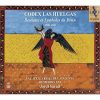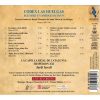CODEX LAS HUELGAS
Bestiaire et Symboles du Divin
Hespèrion XXI, Jordi Savall, La Capella Reial de Catalunya
17,99€
ALIA VOX
AVSA9951
CODEX LAS HUELGAS
Bestiaire et Symboles du Divin
1300-1340
Couvent féminin du Royal Monastère de Santa María de Las Huelgas
Burgos, 1300-1340
Les oracles d’Ézéchiel et les symboles de l’Apocalypse :
L’aigle (Jean), le lion (Marc), le taureau (Lucas) & l’homme (Mathieu)
1. Iocundare, plebs fidelis, cuius Pater est in celis 6’49
(Prose XVIII, E-BUlh, Ms 11, nº 67, f. 60)
Le soleil, la lune et les étoiles à la fin du monde.
2. Audi pontus, audi tellus 5’14
(Conductus XXI, E-BUlh, Ms 11, nº 161, f. 167v, 157)
Les mouches abominables éloignées par la Vierge.
3. Æterni numinis 6’36
(Prose VI, E-BUlh, Ms 11, nº 55, f. 38v)
La colombe, symbole du baptême du Christ.
4. Kyrie, fons bonitatis 4’26
(Organum III, E-BUlh, Ms 11, nº 3, f. 2v)
Le Lion, symbole du pouvoir du Christ.
5. Gaude, Virgo, plena Deo 5’07
(Prose XXVII, E-BUlh, Ms 11, nº 76, f. 73v)
L’aigle, le dragon, la brebis, le lion, le serpent, le bœuf, l’agneau et le ver.
6. Alpha, bovi et leoni / [Domino] 3’49
(Motet III, BUlh, Ms 11, nº 83, f. 84v)
Les Vierges prudentes, symbole de pureté et du Temple de l’Esprit Saint.
7. Virgines egregie Virgines sacrate 4’39
(Prose XXIII, E-BUlh, Ms 11, nº 72, f. 67v)
L’aigle, le serpent et le vaisseau passant sans laisser d’empreinte.
8. Cum sint difficilia Salomoni tria 3’25
(Conductus, École de Notre-Dame, F-Pnm Latin 15139 (St Victor), 270v)
L’astre d’or, les bijoux printaniers, roses, violettes, safran et laurier, symbole de la Reine du Ciel.
9. Virgo sidus aureum 14’26
(Prose VIII, E-BUlh, Ms 11, nº 57, f. 41)
Le soleil, la lune et les étoiles, symbole de la lumière de Marie.
10. O Maria, maris stella / O Maria, Virgo davitica / [In veritate] 5’39
(Motet XXI, E-BUlh, Ms 11, nº 104 f. 102v)
L’auster, vent du sud, symbole de lumière claire et brillante.
11. Flavit auster 3’59
(Prose IX, E-BUlh, Ms 11, nº 58 f. 45)
E-BUlh [Hu] Codex Las Huelgas
Versions musicales de Jordi Savall à partir du Manuscrit du Codex Las Huelgas et consultations des transcriptions de Higini Anglès et Juan Carlos Asensio.
LA CAPELLA REIAL DE CATALUNYA
HESPÈRION XXI
Jordi Savall
rebec, vielle d’archet & direction
_
THE BESTIARY AND DIVINE SYMBOLS
Monastery of Santa María la Real de Las Huelgas (Burgos)
The forest of mysticism is not easily penetrated. There are no beaten paths. The last veil of reality cannot be lifted. Mysticism watches and reveals.
Raimon Panikkar
In the monastic life of the Cistercian order, as in the case of the female monastery of Santa María la Real de Las Huelgas (Burgos), a royal pantheon, the seat of coronations and the epicentre of a very intense musical life in which singing played an extremely important part, the nuns were called upon to live a life of simplicity, silence, prayer and contemplation. Flavit auster, which is part of the Las Huelgas Codex, is a Marian text inspired in the Song of Songs in which the most powerful symbols of femininity appear, such as the honeycomb, milk and honey, and protectiveness described as “mother of mercy, port of hope for the shipwrecked and virgin mother purified.” We also find these symbols as early as the 9th century in Islamic and Jewish spirituality where we are taught the nature of the journey within, a path of challenges, knowledge, of the soul’s encounter and union with God. As St Teresa writes, “see this shining castle and this beautiful Oriental pearl, this tree of life which is planted in the very living waters of life.”
Along with this fascinating symbolism of the Queen of Heaven radiant with light among the stars, the golden star, the sun and the moon, as well as the image of milk and honey, flowers, the jewels of Spring, roses, violets, saffron and laurel, in the Las Huelgas Codex we find many animal symbols of Christ, as they were present at the dawn of Christianity. Let us remember the lambs, doves and fish depicted in the frescoes of the early Christian catacombs and Byzantine mosaics. The reality of this world is at once both mystically reflected and veiled. The roots of Christianity are to be found in Platonic teaching, and it was in this philosophical context, which in turn drew on Egyptian and Hindu wisdom, that the new faith was born.
+ information in the CD booklet
JORDI SAVALL
Konya, 23rd September, 2022











Share